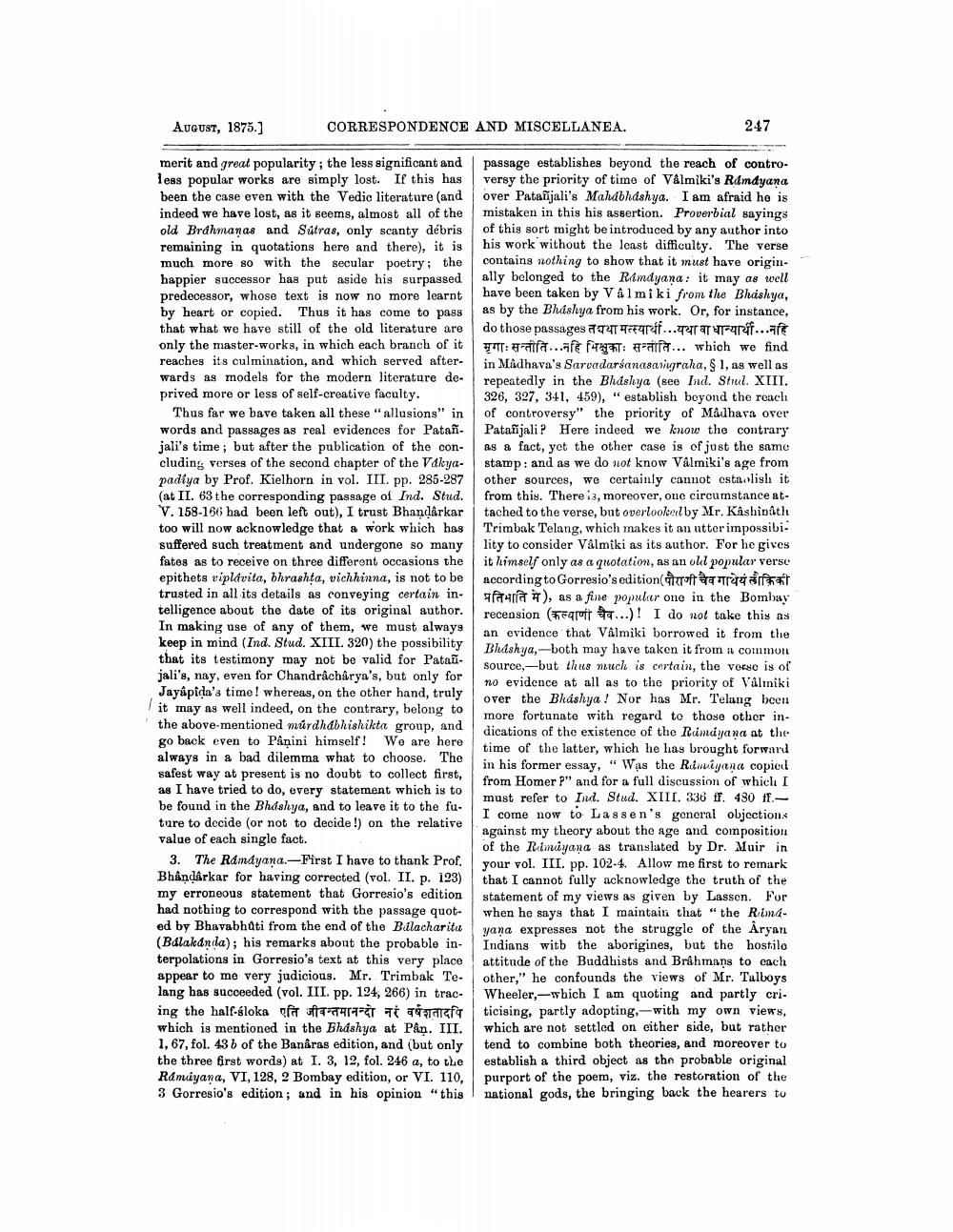________________
AUGUST, 1875.]
CORRESPONDENCE AND MISCELLANEA.
247
merit and great popularity; the less significant and less popular works are simply lost. If this has been the case even with the Vedic literature (and indeed we have lost, as it seems, almost all of the old Brahmanas and Sútras, only scanty débris remaining in quotations here and there), it is much more so with the secular poetry; the happier successor has put aside his surpassed predecessor, whose text is now no more learnt by heart or copied. Thus it has come to pass that what we have still of the old literature are only the master-works, in which each branch of it reaches its culmination, and which served afterwards as models for the modern literature deprived more or less of self-creative faculty.
Thus far we bave taken all these "allusions" in words and passages as real evidences for Patafijali's time; but after the publication of the concluding verses of the second chapter of the Vakya. padiya by Prof. Kielhorn in vol. III. pp. 285-287 (at II. 63 the corresponding passage of Ind. Stud. V. 158-166 had been left out), I trust Bhandarkar too will now acknowledge that a work which has suffered such treatment and undergone so many fates as to receive on three different occasions the epithets viplavita, bhrashta, vichhinna, is not to be trusted in all its details as conveying certain intelligence about the date of its original author. In making use of any of them, we must always keep in mind (Ind. Stud. XIII. 320) the possibility that its testimony may not be valid for Patasjali's, nay, even for Chandracharya's, but only for Jayapida's time! whereas, on the other hand, truly it may as well indeed, on the contrary, belong to the above-mentioned murdhabhishikta group, and go back even to Pâņini himself! We are here always in a bad dilemma what to choose. The safest way at present is no doubt to collect first, as I have tried to do, every statement which is to be found in the Bhashya, and to leave it to the future to decide (or not to decide!) on the relative value of each single fact.
3. The Ramayana.-First I have to thank Prof. Bhandarkar for having corrected (vol. II. p. 123) my erroneous statement that Gorresio's edition had nothing to correspond with the passage quoted by Bhavabhati from the end of the Billacharitu (Balakanda); his remarks about the probable interpolations in Gorresio's text at this very place appear to me very judicious. Mr. Trimbak Telang has succeeded (vol. III. pp. 124, 266) in tracing the half-sloka एति जीवन्तमानन्दो नरं वर्षशतादपि which is mentioned in the Bhashya at Pân. III.
1, 67, fol. 43 b of the Banaras edition, and (but only the three first words) at I. 3, 12, fol. 246 a, to the Rámyana, VI, 128, 2 Bombay edition, or VI. 110, 3 Gorresio's edition ; and in his opinion this
passage establishes beyond the reach of controversy the priority of time of VÅlmiki's Ramdyana over Patañjali's Mahdbhashya. I am afraid he is mistaken in this his assertion. Proverbial sayings of this sort might be introduced by any author into his work without the least difficulty. The verse contains nothing to show that it must have originally belonged to the Ramdyana: it may as well have been taken by Valmiki from the Bluishya, as by the Bhashya from his work. Or, for instance, do those passages
a t Hearif... Tar...af TT: ... f FELT: #ata... which we find in Madhava's Sarvadarśanasaviugraha, S1, as well as repeatedly in the Bhdshya (see Ind. Stred. XIII. 326, 327, 341, 459), "establish beyond the reach of controversy" the priority of Madhava over Patañjali? Here indeed we know the contrary as a fact, yet the other case is of just the same stamp: and as we do not know Valmiki's age from other sources, we certainly cannot estawlislı it from this. There i3, moreover, one circumstance at. tached to the verse, but overlookecil by Mr. Kashipath Trimbak Telang, which makes it an utter impossibility to consider Valmiki as its author. For he gives it himself only as a quotation, as an oll popular verso according to Gorresio's edition of raakt
fauna ), as a fine popular one in the Bombay recension (haruft a...)! I do not take this as an evidence that Valmiki borrowed it from the Blutshya,-- both may have taken it from a common source, but thus much is certain, the verse is of no evidence at all as to the priority of Valmiki over the Bhashya ! Nor has Mr. Telang been more fortunate with regard to those other indications of the existence of the Ruimdyana at the time of the latter, which he has brought forward in his former essay, "Was the Ramayana copied from Homer P" and for a full discussion of which I must refer to Ind. Stud. XIII. 336 ff. 430 ff. - I come now to Lassen's general objections against my theory about the age and composition of the Rimiyaņa as translated by Dr. Muir in your vol. III. pp. 102-4. Allow me first to remark that I cannot fully acknowledge the truth of the statement of my views as given by Lassen. For when he says that I maintain that "the Rind. yana expresses not the struggle of the Aryan Indians witb the aborigines, but the hostilo attitude of the Buddhists and Brahmans to each other," he confounds the views of Mr. Talboys Wheeler, which I am quoting and partly cri. ticising, partly adopting, -with my own views, which are not settled on either side, but rather tend to combine both theories, and moreover to establish a third object as the probable original purport of the poem, viz. the restoration of the national gods, the bringing back the hearers tu




